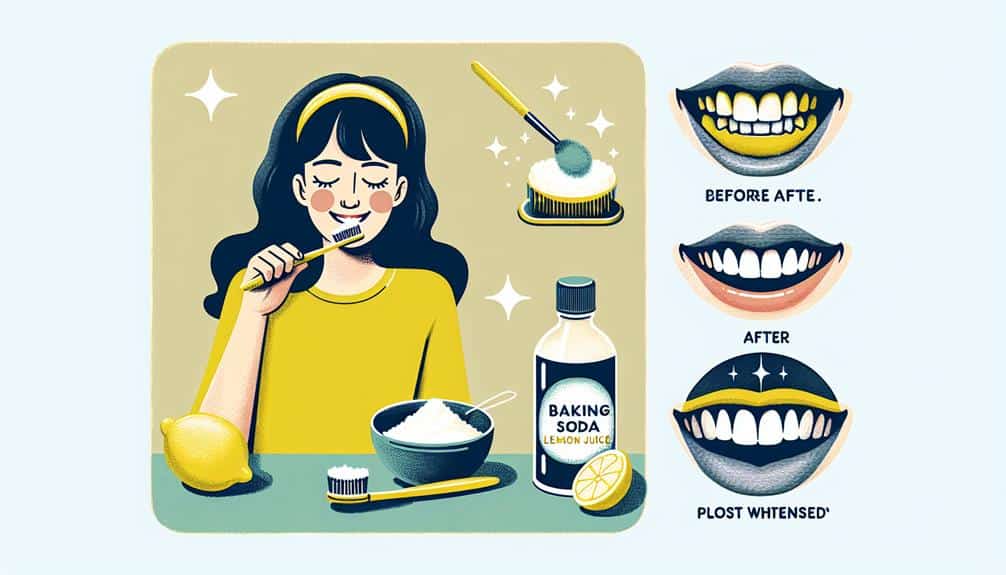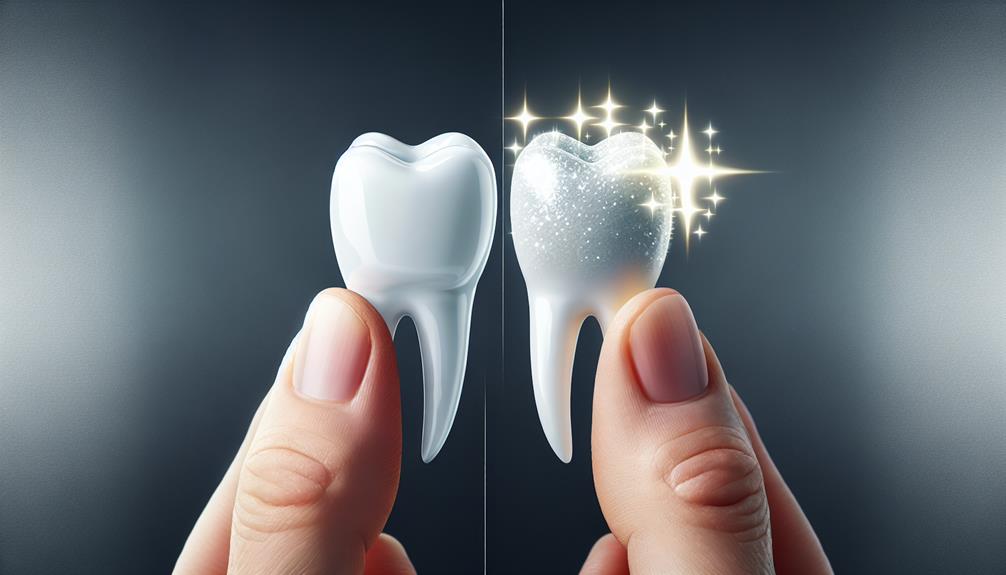To achieve whiter teeth at home, consider trying natural remedies like dried sage leaves and activated charcoal or opt for baking soda toothpaste. Incorporating oil pulling with certain oils can help remove bacteria and promote oral health. Lemon juice and baking soda paste or activated charcoal are effective in combating stains, but always consult with a dentist beforehand. Proper usage instructions, like using hydrogen peroxide mouthwash in importance. Remember, consistency is key, and following guidelines and good oral hygiene practices can further enhance whitening benefits.
Key Points
- Use activated charcoal for surface stain removal and a brighter smile.
- Incorporate oil pulling with antibacterial oils into daily oral care routine.
- Create a lemon juice and baking soda paste for gentle teeth whitening.
- Consult a dentist before trying any at-home teeth whitening remedy.
- Follow proper instructions and precautions when using hydrogen peroxide mouthwash.
Natural Teeth Whitening Remedies
If you're looking to naturally whiten your teeth at home, incorporating these proven remedies into your routine can help achieve a brighter smile. Herbal remedies are a popular choice for those seeking DIY solutions for teeth whitening. For example, using dried sage leaves as a tooth powder has been shown to help remove surface stains and promote a whiter appearance. Additionally, the antimicrobial properties of sage can contribute to overall oral health.
Another effective herbal remedy is activated charcoal. While it may seem counterintuitive to use a black substance to whiten teeth, activated charcoal has absorbent properties that can bind to toxins and stains on the teeth, helping to remove them effectively. When using herbal remedies, it's essential to do so cautiously and consult with a dental professional if you have any concerns about their usage.
Incorporating these natural solutions into your oral care routine can be a safe and cost-effective way to achieve a brighter smile.
Baking Soda Toothpaste
To continue your journey towards achieving a brighter smile at home, let's explore the effectiveness of baking soda toothpaste in whitening stained teeth. Baking soda, or sodium bicarbonate, has been long celebrated for its teeth-whitening benefits. When utilized in homemade toothpaste, baking soda can assist in eliminating surface stains on teeth caused by coffee, tea, or tobacco. Its gentle abrasive properties aid in scrubbing away plaque and discoloration without causing harm to the enamel.
One of the primary advantages of using baking soda toothpaste is its capability to neutralize acids in the mouth, which can contribute to tooth decay and staining. Additionally, baking soda possesses antibacterial properties that can help reduce harmful bacteria in the mouth, promoting better oral health overall.
When concocting your homemade toothpaste with baking soda, make sure it's blended with water or a mild toothpaste to prevent abrasive damage to the teeth. While baking soda can be efficient in brightening teeth, it's crucial to use it in moderation to avoid any negative effects on your oral health.
Oil Pulling for Whiter Teeth
If you're looking for a natural way to whiten your teeth at home, oil pulling might be just what you need. This ancient Ayurvedic practice involves swishing oil around in your mouth to help remove bacteria and promote oral health.
Stay tuned to discover the benefits of oil pulling, learn how to do it correctly, and get some useful tips for incorporating this technique into your oral care routine.
Oil Pulling Benefits
Implementing oil pulling as a part of your oral hygiene routine can provide significant benefits for achieving whiter teeth. Oil pulling involves swishing oil around in your mouth for a few minutes to help remove plaque and bacteria. Here are four key benefits of oil pulling:
- Oral Health Improvement: Oil pulling can help reduce harmful bacteria in your mouth, promoting healthier gums and fresher breath.
- Detoxification Benefits: By pulling out toxins from your mouth, oil pulling aids in detoxifying your body through the oral cavity.
- Whitening Effect: The swishing action can help remove surface stains on teeth, gradually leading to a brighter smile.
- Natural Antibacterial Properties: Certain oils used in oil pulling, like coconut oil, possess antibacterial properties that can benefit your oral health.
How to Oil Pull
Enhance your oral hygiene routine by incorporating oil pulling for whiter teeth. Oil pulling involves swishing oil in your mouth to remove bacteria and promote oral health.
This ancient practice has gained popularity for its numerous benefits, including whitening teeth and improving overall oral health. Oil pulling works by pulling out toxins and bacteria from your mouth, which can contribute to stains on your teeth.
Additionally, this technique can help reduce plaque buildup, prevent bad breath, and promote healthy gums. By incorporating oil pulling into your daily routine, you can experience not only whiter teeth but also a fresher and healthier mouth.
Start reaping the oral health benefits of oil pulling today.
Oil Pulling Tips
To optimize the benefits of oil pulling for whiter teeth, make sure you use high-quality, organic coconut or sesame oil. When practicing oil pulling, follow these tips for the best results:
- Coconut Oil Benefits: Coconut oil has antimicrobial properties that can help reduce bacteria in the mouth, promoting oral health.
- Coconut Oil Risks: While rare, some individuals may experience stomach discomfort if large amounts of oil are accidentally swallowed during oil pulling.
- Sunflower Oil Technique: If using sunflower oil for oil pulling, swish it around in your mouth for about 15-20 minutes to help remove stains from the teeth effectively.
- Sunflower Oil Results: With consistent use, sunflower oil can contribute to a brighter smile by reducing the appearance of stains on the teeth.
Lemon Juice and Baking Soda Paste
For brighter teeth at home, consider creating a paste using lemon juice and baking soda. Lemon juice is known for its natural bleaching properties, while baking soda acts as a mild abrasive to help remove surface stains on teeth. When combined, these two ingredients form a powerful yet gentle paste that can help whiten stained teeth.
However, it's important to be cautious when using citrus-based remedies like lemon juice due to their acidic nature. The acidity can potentially erode the enamel if used excessively or over a prolonged period. To protect your enamel, it's advisable to use this paste sparingly and not as a daily routine.
As with any DIY alternatives for teeth whitening, moderation is key to prevent any damage to your teeth. Remember to consult with your dentist if you have any concerns about using acidic remedies on your teeth.
Activated Charcoal for Stained Teeth
To explore another effective method for whitening stained teeth at home, consider utilizing activated charcoal. Activated charcoal is known for its ability to absorb toxins and stains, making it a popular choice for teeth whitening.
Here are some key points to help you understand the benefits of charcoal toothpaste and its whitening method:
- Charcoal Toothpaste Benefits:
- Charcoal toothpaste is effective in removing surface stains from the teeth, resulting in a brighter smile.
- It helps balance the pH levels in the mouth, reducing the risk of cavities and gum disease.
- Charcoal toothpaste is a natural and safe alternative to chemical-based whitening products.
- The antibacterial properties of activated charcoal can help freshen breath and promote overall oral health.
- Charcoal Teeth Whitening Method:
- To whiten your teeth using activated charcoal, dip a wet toothbrush into powdered charcoal and brush your teeth gently for 2 minutes.
- Rinse your mouth thoroughly until all the charcoal residue is removed.
- Repeat this process 2-3 times a week for best results.
- Remember to consult your dentist before trying any new teeth whitening method.
Hydrogen Peroxide Mouthwash
Hydrogen peroxide mouthwash is recognized for its whitening properties, making it a popular choice for enhancing the color of stained teeth.
When utilizing this mouthwash, make sure you adhere to correct usage instructions to achieve the desired results effectively.
It's crucial to be mindful of potential risks and take necessary precautions to avoid any adverse effects on your oral health.
Whitening Properties of Hydrogen Peroxide
Enhancing your oral care routine with hydrogen peroxide mouthwash can effectively whiten stained teeth due to its powerful whitening properties. Hydrogen peroxide works by breaking down stains on the surface of the teeth, revealing a brighter smile.
To maximize the whitening benefits of hydrogen peroxide mouthwash, consider the following:
- Concentration Matters: Opt for a safe concentration of hydrogen peroxide to avoid any potential side effects.
- Consistency is Key: Regular use of hydrogen peroxide mouthwash can lead to noticeable improvements in teeth color over time.
- Follow Guidelines: Always follow recommended guidelines for using hydrogen peroxide to ensure safety and effectiveness.
- Combine with Good Oral Hygiene: Brushing and flossing alongside hydrogen peroxide mouthwash can enhance whitening results.
Proper Usage Instructions
Considering the whitening properties of hydrogen peroxide mouthwash, the proper usage instructions play a significant role in achieving ideal results for brightening stained teeth. To maximize its effectiveness, start by brushing your teeth thoroughly before using the mouthwash to make sure plaque and debris are eliminated.
When using hydrogen peroxide mouthwash, timing is important – swish it around your mouth for about 30 seconds to 1 minute before spitting it out. Consistency in application is key; use the mouthwash once a day for about 1 to 2 weeks, and then reduce to 2-3 times a week to maintain results.
Following these brushing techniques, timing tips, and frequency recommendations can help you achieve a brighter smile effectively.
Potential Risks and Precautions
To ensure safe and effective use of hydrogen peroxide mouthwash, it's crucial to be aware of potential risks and take necessary precautions. When using hydrogen peroxide mouthwash for teeth whitening, consider the following precautions:
- Dilution: Always dilute the hydrogen peroxide as directed to prevent irritation or damage to oral tissues.
- Duration: Don't exceed the recommended duration of use to avoid sensitivity or harm to the enamel.
- Frequency: Limit the frequency of use to prevent overuse, which could lead to negative effects on oral health.
- Consultation: If you have sensitive teeth, gum disease, or other oral issues, consult a dentist before using hydrogen peroxide mouthwash to mitigate risks.
Strawberry and Baking Soda Scrub
For a natural teeth-whitening remedy, consider trying the Strawberry and Baking Soda Scrub. Strawberries contain malic acid, a natural astringent that aids in removing surface tooth discoloration through exfoliation. Additionally, the fruit's vitamin C content can help break down plaque that causes teeth to look yellow. When combined with baking soda, which is known for its mild abrasive properties, this scrub can offer a gentle yet effective way to whiten stained teeth at home.
To create the scrub, mash one ripe strawberry and mix it with half a teaspoon of baking soda until it forms a paste. Apply the mixture to your teeth using a soft-bristled toothbrush, gently scrub for a couple of minutes, and then leave it on for five minutes before rinsing thoroughly.
While this natural remedy can be effective in brightening your smile, using in moderation is crucial to prevent enamel erosion. Limit usage to once or twice a week, and if you experience any sensitivity or discomfort, discontinue use immediately.
Frequently Asked Questions
Are There Any Risks or Side Effects Associated With Using Natural Teeth Whitening Remedies?
When utilizing natural teeth whitening remedies, potential risks and side effects may include tooth sensitivity, gum irritation, or enamel damage. It is crucial to be cautious and follow instructions carefully to minimize these issues.
How Often Should I Use Baking Soda Toothpaste to See Noticeable Results?
To see noticeable results using baking soda toothpaste, use it every other day. Its effectiveness can help whiten teeth, but be cautious with frequency to avoid enamel damage or increased sensitivity. Consistency is key.
Can Oil Pulling for Whiter Teeth Also Help Improve Overall Oral Health?
Oil pulling, a debated oral hygiene practice, offers potential benefits for whiter teeth and overall oral health. While some claim improvements, scientific evidence is limited. Consider incorporating oil pulling cautiously into your oral care routine.
Is It Safe to Use Lemon Juice and Baking Soda Paste on Sensitive Teeth?
When handling sensitive teeth, it's important to avoid lemon juice and baking soda paste. Lemon juice alternatives and baking soda substitutes are gentler on enamel. Prioritize sensitivity precautions and tooth enamel protection for a healthier oral care routine.
How Long Does It Take to See Results From Using Activated Charcoal for Stained Teeth?
When using activated charcoal toothpaste for stained teeth, timing varies. Results may appear after a few weeks of consistent use. Compared to DIY baking soda methods, charcoal's effectiveness is usually noticed sooner, offering a quicker whitening solution.
Conclusion
To wrap up, these 7 proven ways to whiten stained teeth at home offer natural and effective solutions for a brighter smile.
From using baking soda toothpaste to trying oil pulling, there are various options to choose from.
So why not give these remedies a try and say goodbye to those stubborn stains?
Your teeth will thank you as they shine like diamonds in the sky!



